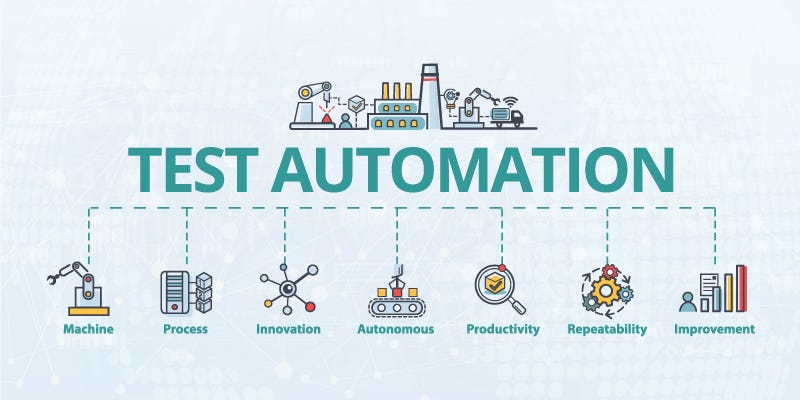Automation Testing Frameworks: Streamlining Complex Testing Circumstances
Automation Testing Frameworks: Streamlining Complex Testing Circumstances
Blog Article
From Guidebook to Automated Screening: A Comprehensive Guide to Transitioning Smoothly and Effectively
In the world of software application testing, the shift from guidebook to automated processes has actually ended up being an increasingly vital change for companies seeking to boost performance and accuracy in their testing practices. As innovation continues to breakthrough, the need for seamless and reliable computerized testing methods has actually never been extra important. The journey from handbook to automated testing is not without its difficulties, however when come close to purposefully and with a clear plan in mind, the advantages can be considerable - automation testing. In this extensive guide, we will certainly discover essential actions and considerations crucial for an effective shift, from the first option of devices to the combination of automation into existing operations. Remain tuned to reveal the understandings that will aid lead the way for a smoother and a lot more effective screening process.
Advantages of Automated Evaluating
Automated screening offers various advantages, enhancing performance and precision in software application advancement processes. Automated tests can be run all at once on numerous tools and operating systems, considerably speeding up the screening stage contrasted to hands-on testing.
Additionally, automated screening guarantees a greater degree of precision in finding flaws. Given that automated tests follow predefined scripts, human mistake is reduced, leading to more reputable test outcomes. Uniformity in testing is also improved, as automated examinations execute the same actions specifically each time they are run. This uniformity is critical in making certain that all functionalities of the software are extensively examined, lowering the probability of unseen bugs sliding via to manufacturing.
Picking the Right Tools

Firstly, assess your purposes and demands. Understand the range of your task, the innovations involved, and the ability of your team. This evaluation will certainly help you determine the capacities and attributes you call for in your testing tools.
Second of all, take into consideration the compatibility of the devices with your existing systems and procedures. Seamless assimilation with your present software program growth lifecycle is vital to make sure a smooth shift to automation.
Additionally, review the scalability and versatility of the tools. As your screening needs develop, the devices should be able to adapt and suit changes properly.
Last but not least, consider the assistance and neighborhood around the devices. When carrying out automated screening, durable assistance and an active individual neighborhood can provide valuable sources and assistance. By carefully thinking about these elements, you can choose the right devices that line up with your demands and set the phase for a successful shift to automated screening.
Creating Effective Test Manuscripts

When crafting test manuscripts, it is necessary to consider the particular demands of the software being tested and guarantee that the manuscripts resolve all crucial performances. Detailed and clear calling conventions for examination manuscripts and test situations can enhance readability and maintainability. In addition, integrating mistake handling systems within the test manuscripts can help in identifying and addressing concerns immediately.
Furthermore, organizing examination scripts into modular elements can enhance reusability and scalability, reducing redundancy and improving efficiency in examination script maintenance. Normal evaluations and updates to check manuscripts are essential to equal progressing software application demands and functionalities. By adhering to these principles, testers can develop durable and reliable test scripts that add dramatically to the success of automated testing procedures.
Integrating Automation Into Workflows
Reliable combination of automation tools right into existing process enhances and enhances processes performance within software application advancement cycles. When integrating automation into workflows, it is vital to identify recurring jobs that can be automated to save time and minimize human mistake. By seamlessly integrating automated screening devices like Selenium or Appium into the software application growth lifecycle, groups can achieve faster comments on code changes, causing quicker pest detection and resolution. This integration enables constant testing throughout the development process, guaranteeing that any concerns are determined early, causing greater software application high quality. Additionally, automation can be used to set off tests automatically after each code commit, offering instant validation and freeing up testers to focus on more complex situations. Appropriate combination of automation tools needs partnership between development, testing, and operations groups you could try these out to establish a unified workflow that maximizes performance and performance in delivering top quality software.
Making Certain a Smooth Shift
Effectively transitioning to automated testing entails meticulous planning and careful implementation to lessen disturbances and maximize effectiveness in the software growth procedure - automation testing. To guarantee a smooth change, it is important to start by conducting a comprehensive evaluation of the present screening processes and recognizing areas where automation can bring the most significant advantages. Involving with all stakeholders at an early stage at the same these details time, consisting of designers, testers, and job supervisors, is crucial for amassing assistance and buy-in for the automation campaign
Interaction is essential during this shift phase. Clear communication of the goals, benefits, and expectations of automated testing helps to handle any type of resistance or issues that might arise. Furthermore, offering sufficient training and resources for staff member to upskill in automation devices and strategies is crucial for making sure an effective shift.

Verdict
In verdict, transitioning from handbook to automated testing uses various advantages, including enhanced performance and integrity. By choosing the proper tools, creating efficient examination scripts, and incorporating automation seamlessly into workflows, companies can guarantee a smooth and successful shift. It is vital to welcome automation as a valuable property in software program testing processes to enhance general quality and performance.
In the world of software screening, the change from handbook to automated processes has become a progressively vital change for companies seeking to improve efficiency and precision in their testing practices. Automated examinations can be run all at once on several gadgets and operating systems, considerably speeding up the screening stage compared to hand-operated testing. Uniformity in testing is also improved, as automated examinations implement the very same steps exactly each time they are run.To guarantee the successful execution of picked screening devices, the creation of effective examination scripts plays an essential role in validating the functionality and efficiency of automated procedures - automation testing. By complying with these article concepts, testers can develop effective and durable test manuscripts that add significantly to the success of automated testing processes
Report this page